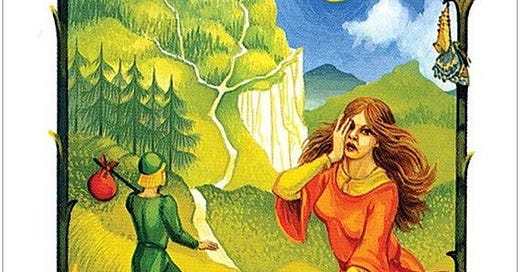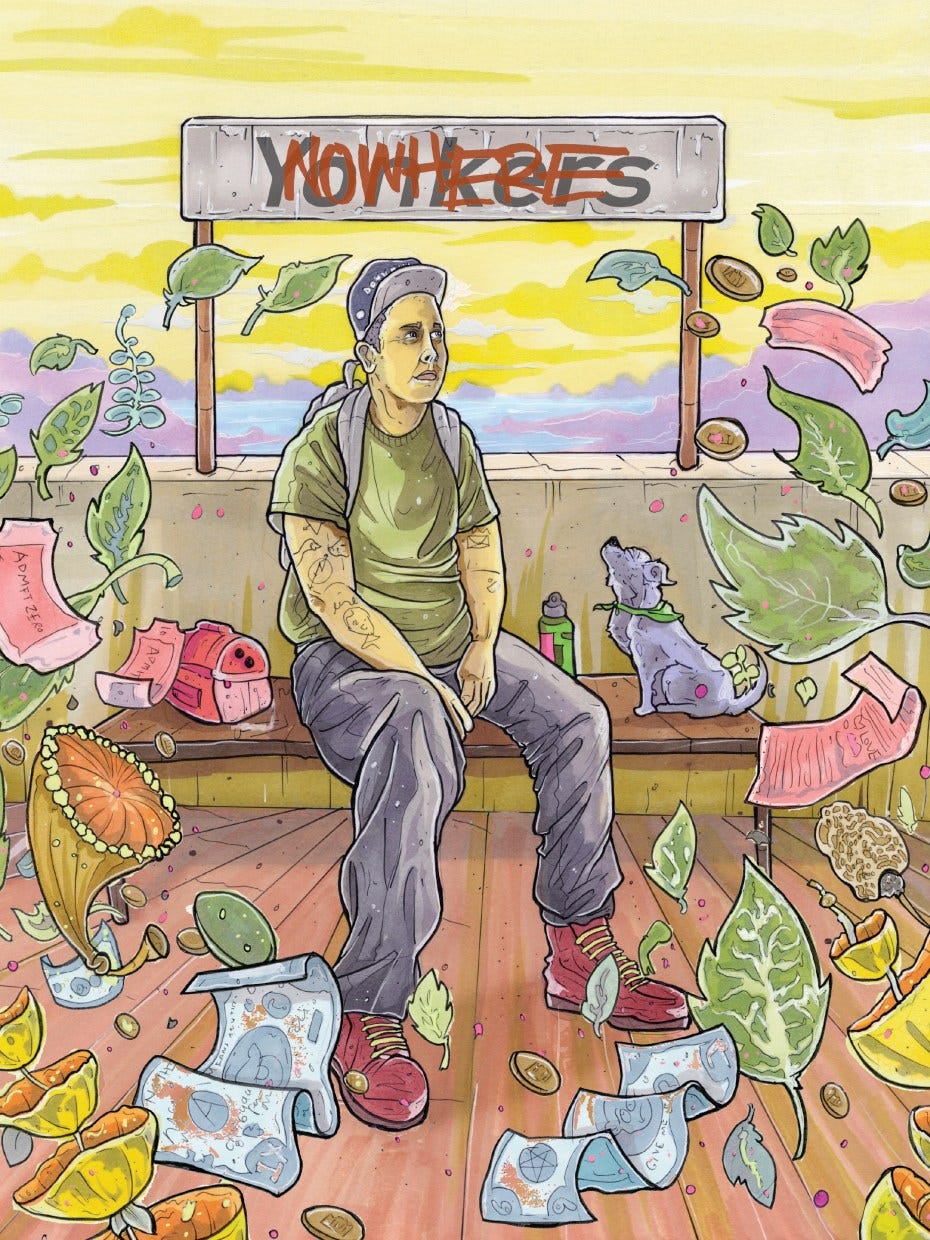In Tarot, the Fool is the first card of the major arcana and is labelled as card 0 or 78. It begins or ends the cycle. The journey that the Tarot tells moves in a spiral, with endings and beginnings happening continuously or often, simultaneously.
My first tarot deck was gifted to me by a stranger from Brazil. It is the Old Path deck and is still the deck I use, the only deck I own. I have an affinity to it because it was a gift and because it is the deck I am learning on. However, I do feel distance from the all white cast of characters, shown only in heterosexual cis relationships. But as this is the deck I use, the depiction of Fool in this deck comes to my mind when I consider this archetype.
In the card, the Fool is walking down a dirt path with a bag over their shoulder. They are beginning a journey, and their eyes are cast forward. The road above them is hilly and breaks into several paths in the distance. Though the sun is beaming in the sky, clouds linger in the fray. Change, conflict, and choice are present in this card. A butterfly emerges from a chrysalis in the card’s border. A partridge, which uses deceptive methods to protect itself, watches the Fool walking by. Goldenrod sprouts out of the ground and encourages good luck and growth. In the foreground, a baby crawls across the grass and reaches into the fire. Their hand is charred and burnt by the flames. A woman, presumably the baby’s mother, run towards them and holds her face in flustered tears. But the Fool doesn’t seem to mind or even notice. They are undertaking a journey, and their eyes are poised towards the steps they will soon take.
The Fool is at the beginning of their journey and has a lot to learn along the way. The baby with their hand burnt is a reminder that learning can leave scars. The choices we make can cause us harm. Studying the Fool, I admire their sense of purpose and excitement. If you think you know too much, you get rigid. You close up. The Fool, in all their oblivion, is open.
Cristy C. Croad’s Next World Tarot shows the Fool as a traveler kid, going in the direction of anything with their dog by their side. Nowhere is tagged over Yonkers. They look solemn and look towards the sky for guidance. Soon, they will have to make choices. But they aren’t there yet. They’re still beginning.
As much as I admire the Fool, I can’t say I always embrace the archetype whole heartedly. I want to look smart and sound like I know what I’m talking about. This desire to sound smart is a thread that can be untangled. What does it mean to look smart? To sound smart? What is knowledge? Whom is it for? What kinds of knowledge are respected?
Asking these questions leads me to look at white supremacy, my whiteness, and institutions of power which create norms of what is valuable knowledge. Many have spoken about how colonization and white supremacy write off lived experience, familial stories, oral histories, and intuition as forms of knowledge. In a mainstream sense, to be seen as smart is to be in line with power structures. It is to continue the historical and cultural lineage of power, white supremacy, and colonization which the country I live in, the United States, is built on.
What I’m getting at, and I know I’m not the first one to say this, is that the pressure to appear smart is a racist, classist classification that is influenced by, and reinforces, power structures. Who is smart and who isn’t is a way of saying who is worth listening to and who is not. This is often presented as binaries, where we are expected to choose which side we belong on. The right side or the wrong one. I am interested in how we can disrupt these illusions of clear boundaries and binaries, and how the Fool can be a helpful archetype for this.
Which makes me question, what does it mean to look like a fool? And how does embracing and embodying a sense of foolishness work towards interrogating and disrupting notions of knowledge and power? Looking like a fool could mean asking questions and admitting you don’t know. Or trying new things and moving outside of known territory. The Fool is in a liminal space. They are shown in process–in between selves, worlds, and norms.
This week, reading Dodie Bellamy’s essay collection When the Sick Rule the World, I was struck by the epigraph. A quote by artist Mike Kelley reads,
What I dislike about most contemporary artists is that they want to be hipsters. They’re not willing to be fools.
To embrace the Fool is to recognize liminality and change. The Fool is on a journey. This journey is aided by their adaption and fluidity. Without discerning judgement, their openness could lead them to pain. But it can also lead them to growth, adventure, and new possibilities. I would like to embrace the Fool and disrupt, make mistakes, and wink at you as I pass you on the road.
Perhaps, as Croad’s tarot deck’s name suggests, the Fool is on a journey to the next world. Self-definitions are always shifting. Desiring to always be smart and in the know means staying within familiar territory. It means being closed off and rigid. Being closed off may provide a sense security, but it is a false security. Change is inevitable and constant. The Fool reminds us that openness, adaptability, and fluidity can aid us. We are always moving between selves, ideas, and forms. Perhaps the next world is always beginning within us.
This week:
Yay, news about creative projects ~~
A recording of my poem titled Backdrop of Green Light was released on Hello America’s Winter 2022 compilation. This comes in cassettes and audio downloads. Listen or buy here.
After years of writing poems in one long doc, I have compiled a manuscript. A small publisher I have long admired is interested in putting it out. I haven’t signed anything but I am very excited to have this develop over time! Feels good to think, Yeaahhh! I wrote all these poems







Thanks for sharing, praise be to the fool!